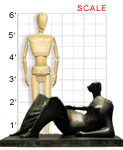VAM galleries including this work:
The Speed Art Museum | Go Figure | Art Through Time || VAM Home
Henry Moore (English, 1898-1986)
RECLINING FIGURE: ANGLES, 1979
Bronze, 86" in length
Gift of Sara Shallenberger Brown in memory of W.L. Lyons Brown 81.21
© ARSNY
The Speed Art Museum
This bronze, with its undulating form and abstract interpretation of the reclining human figure, is an example of the large-scale sculpture for which Modern artist Henry Moore is best known.
Modern art encompassed many diverse artistic styles and approaches from approximately 1900 to 1980. In general, those artists preferred to break new ground rather than follow the traditions and conventions of past art. Modern artists strove to express their response to the world by developing their own new and uniquely personal styles and processes. Reflecting this approach, instead of depicting the human form in a realistic, true-to-life manner, Henry Moore stylized and abstracted it in ways that call forth additional ideas and associations in the viewer.
About the Artist
Henry Spencer Moore was born in Castleford, West Yorkshire, England, the seventh of eight children. His father, a mining engineer, viewed education as the way his children could avoid working in the mines. Moore decided to become a sculptor when he was only 11 and was encouraged by teachers to begin modeling in clay and carving in wood. He studied at the Leeds School of Art and later at London’s Royal College of Art, and his early sculptures followed standard teachings in romantic Victorian style. After being influenced by African and pre-Columbian American art and other sculptors such as Constantin Brancusi, Jacob Epstein, and Frank Dobson, he moved to more abstract portrayals. He also moved from direct carving to casting in bronze.
After World War II, Moore’s bronzes took on monumental scale suited to the public art commissions he was receiving, and he began to gain international recognition. For his largest works, he often produced a half-scale working model or full-scale plaster model. After Moore’s wife, Irina, gave birth to their daughter, he began producing many works showing mother and child.
“I see no reason why realistic art and purely abstract art can’t exist in the world side by side at the same time, even in one artist at the same time.”
Over the last three decades of Moore’s life, major retrospective exhibitions of his work were mounted around the world. His growing commissions made him quite wealthy, and he established the Henry Moore Foundation to promote the public appreciation of art and to preserve his own sculptures. The foundation operates Moore’s long-time home and studio, Hoglands, near Much Hadham in Hertfordshire, as a gallery and museum.
Moore broke with a long tradition in art in his portrayal of the human figure. “All art is abstract in one sense,” he wrote. “Not to like abstract qualities or not to like reality is to misunderstand what sculpture and art is all about.... I see no reason why realistic art and purely abstract art can’t exist in the world side by side at the same time, even in one artist at the same time.”
Classroom Ideas
Discussion: What is abstraction, and how does it differ from
realism? Is this sculpture realistic about the human form? Why or why not?
Is it “realistic” in terms of the human experience? Can you recall
an experience when you were younger when a figure seemed to be much larger
than you, or when a figure was almost “formless” in its size or
feeling? Can our experiences and feelings be as “real” as
the outward appearance of an object?
What does the expression on the woman’s face tell us about the ideas
of the artist? (The face
of the sculpture has a very simple, almost childlike face rather than
one with distinctive
features or a particular personality.) Do you think the work was inspired
by an actual woman, or was the artist more interested in the idea of “woman” rather
than a specific woman? Explain your response.
Watch the video segment of
education curator Martin Rollins analyzing this work on Responding to
Visual Art. Compare your response to his.
Can you point out the negative spaces in the sculpture? In an artwork
that is solid and massive in its form, why is it important that it have
areas of open “negative spaces”?
(These negative spaces can be seen to counterbalance
the form—to provide
a kind of visual relief for the viewer.)
Some people think that Moore’s sculptures are influenced by the
landscape of Yorkshire, where he was born. Research Yorkshire geography
and discuss this hypothesis. Look at other reclining figures by Moore
and discuss what they have in common and how each is unique.
Activities: Draw or sculpt yourself or another person in an
abstract style.
Many scholars believe that Moore was influenced by non-Western cultures
in Africa and pre-Columbian America, while the artist himself said he was
influenced by Michelangelo. Research these influences on Henry Moore and create
posters comparing how the human form was portrayed by Michelangelo, in some
of the West African cultures, and in pre-Columbian culture.
Links
Find out more about Moore and his work at the Henry Moore Foundation web site.
[www.henry-moore-fdn.co.uk]
Read a biography of Moore in the Brain Encyclopedia.
[www.brainyencyclopedia.com/encyclopedia/h/he/henry_moore.html]
Find links to Henry Moore works online in the Artcyclopedia.
[www.artcyclopedia.com/artists/moore_henry.html]


